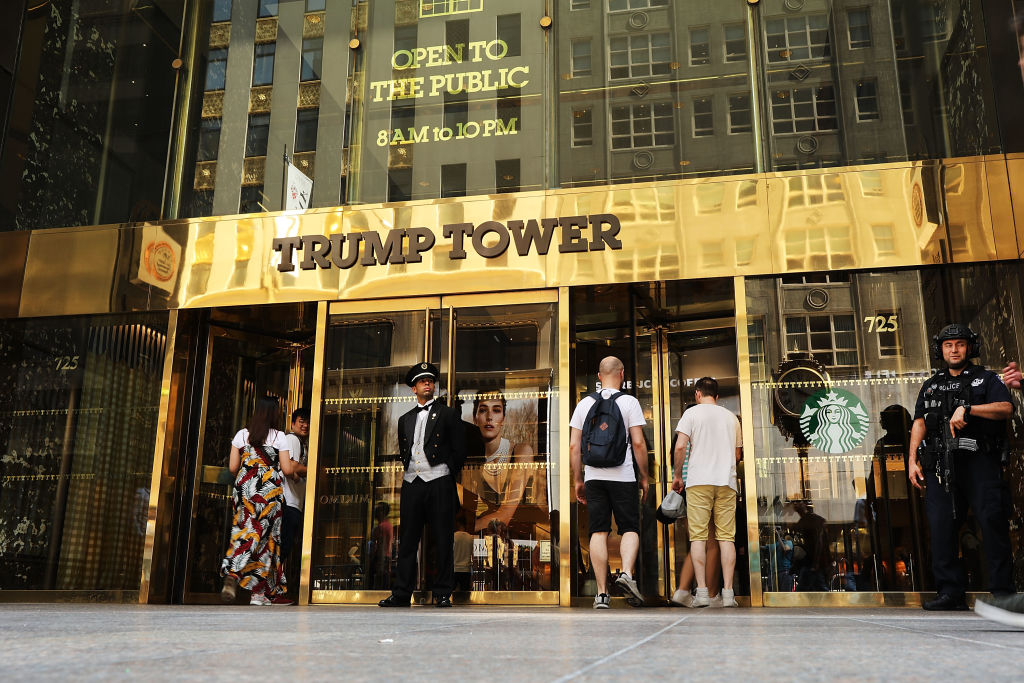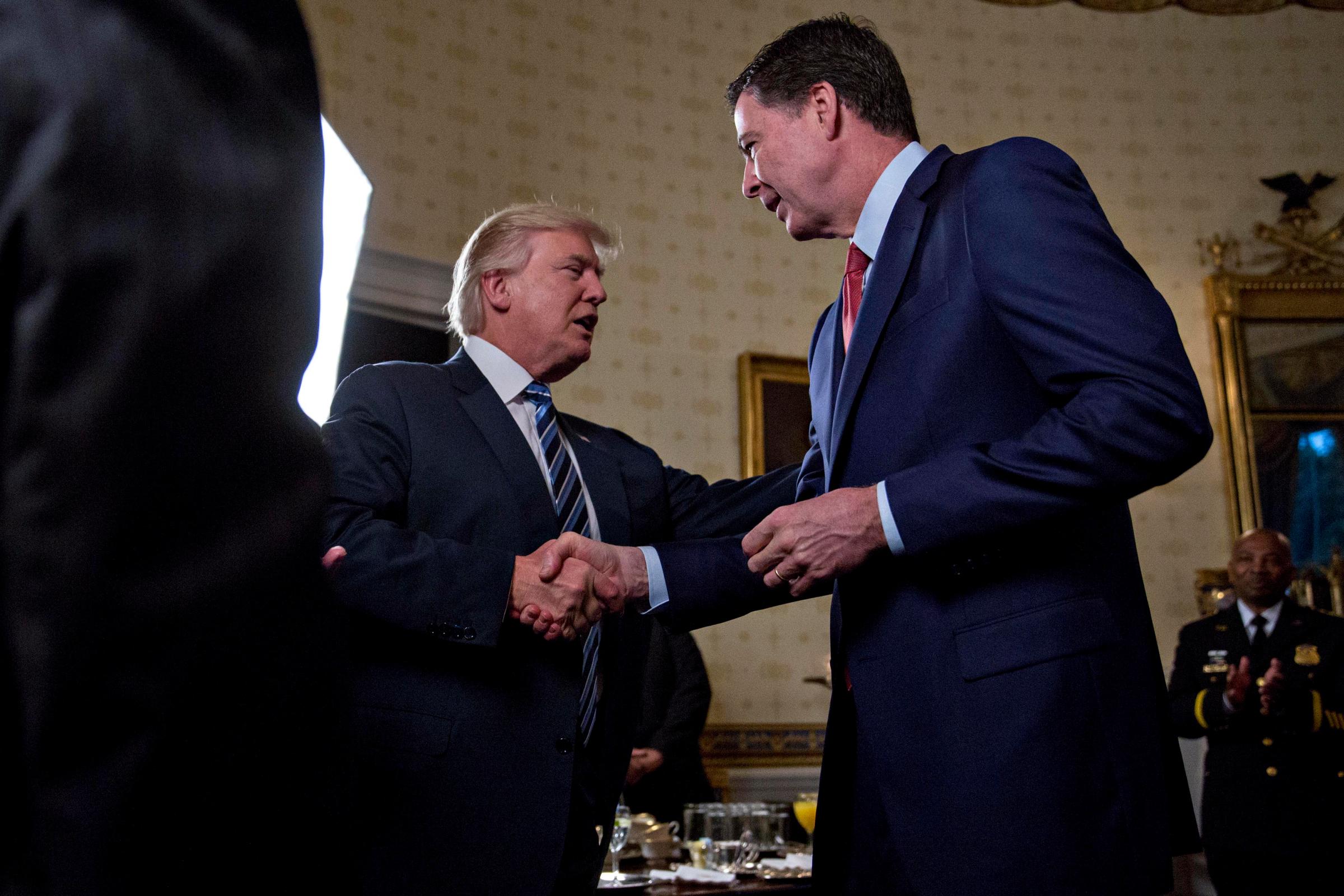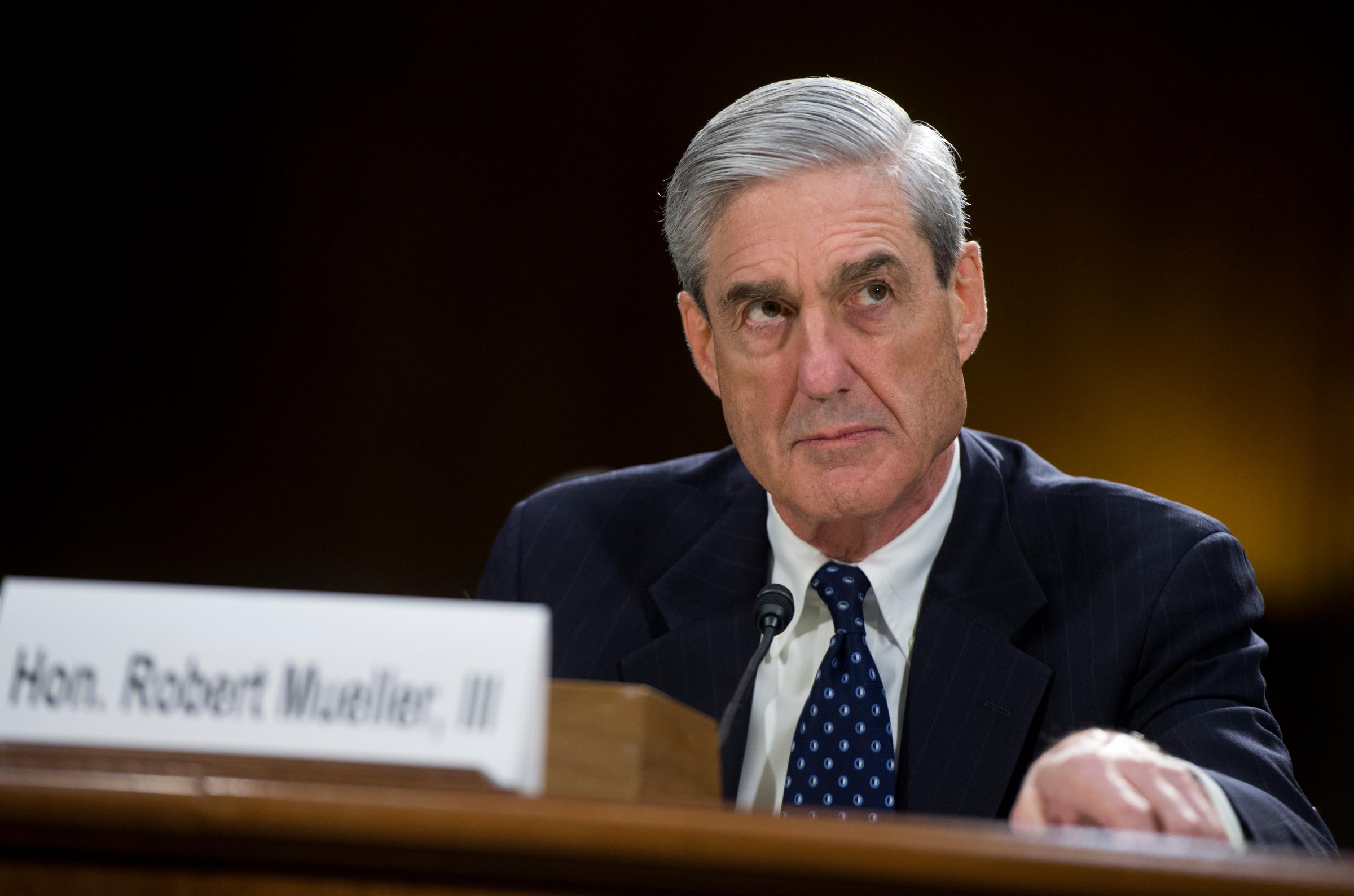President Donald Trump and his staff misled the public on a number of important matters, and even at times on minor details, according to Special Counsel Robert Mueller’s report.
After issuing thousands of subpoenas and interviewing hundreds of witness under oath, Mueller’s team of investigators carefully documented how Trump and his staff made false statements about a meeting with a Kremlin-connected lawyer in Trump Tower and the firing of FBI director James Comey, among other key moments.
The report also provides evidence that how Trump and his staffers would sometimes fail to tell the truth about even inconsequential details.
In an interview with NBC News after the Comey firing, Trump claimed that it was the FBI director’s idea to have a private dinner with him in the White House. “He wanted to have dinner because he wanted to stay on.” But, as Mueller notes, the president’s own daily diary records that it was he who “extend[ed] a dinner invitation” to Comey.
Meantime, White House spokeswoman Sarah Huckabee Sanders defended the firing by claiming that “countless” rank-and-file agents within the FBI had complained about his oversight. But under oath with Mueller’s team, she admitted that claim “was not founded on anything,” calling it a “slip of the tongue.”
Read More: Trump’s Interview With TIME on Truth and Falsehoods
The Trump Administration has long had a troubled relationship with the truth. Trump bragged in his 1987 book The Art of the Deal that he liked to engage in what he called “truthful hyperbole,” while adviser Kellyanne Conway coined the phrase “alternative facts” to defend a plainly false statement about attendance at Trump’s inauguration from a White House spokesman in the Administration’s very first press briefing.
But the Mueller report lays bare exactly how untruthful Trump and his staff were at times. Here’s a look at five key moments.
Fact: Trump pursued a business deal with Russia during the campaign

The facts: The Trump Organization explored building a skyscraper in Moscow from 2015 through June of 2016, just as Trump was clinching the Republican presidential nomination, though Trump repeatedly denied having any business with Russia.
The Mueller report: The Trump Organization began exploring a real estate project in Russia in the summer of 2015. Trump’s personal lawyer Michael Cohen worked on the project, regularly updating Trump, Donald Trump Jr. and Ivanka Trump on its status. In the fall of 2015, Trump signed a letter of intent with Russian partners I.C. Expert Investment Co., which contemplated a project with 250 condominiums and a 15-story luxury hotel plus commercial office space. Felix Sater, who was working with I.C. Expert on the project, believed the project would help Trump’s candidacy. “Putin gets on stage with Donald for a ribbon cutting for Trump Moscow, and Donald owns the republican [sic] nomination,” he wrote Cohen in an email. “And possibly beats Hillary and our boy is in.”
Mueller’s sources: Testimony from Cohen, Sater and I.C. Expert chairman Andrei Rozov; the letter of intent; and emails and text messages about the project.
What Trump said: Cohen testified that he recalled that at one point in the summer of 2016 Trump “publicly claimed that he had nothing to do with Russia and then shortly afterwards privately checked with Cohen about the status of the Trump Tower Moscow project,” according to the report. Trump regularly maintained that he had no loans, business deals, real estate investments or even contacts with Russia. “For the record, I have ZERO investments in Russia,” he tweeted in July of 2016. “I mean I have nothing to do with Russia. I don’t have any jobs in Russia. I’m all over the world but we’re not involved in Russia,” he said that same month in a TV interview. “I know about Russia, but I know nothing about the inner workings of Russia. I don’t deal there. I have no businesses there,” he said during the second presidential debate. “I have no dealings with Russia. I have no deals that could happen in Russia, because we’ve stayed away. … We could make deals in Russia very easily if we wanted to, I just don’t want to because I think that would be a conflict,” he said during a press conference in January of 2017.
Fact: The Trump campaign met with Russians in Trump Tower

The facts: Trump’s campaign chairman Paul Manafort; his son Donald Trump Jr. and his son-in-law Jared Kushner met with a Kremlin-connected lawyer in Trump Tower in June of 2016 after being told they would get incriminating information on Hillary Clinton.
The Mueller report: On June 3, 2016, music publicist Rob Goldstone reached out to Donald Trump Jr., emailing that he had “some official documents and information that would incriminate Hillary and her dealings with Russia” from “the Crown prosecutor of Russia.” Within minutes, Trump Jr. responded, “if it’s what you say I love it.” Trump Jr. invited Manafort and Kushner to the meeting, which was attended by attorney Natalia Veselnitskaya, who had previously worked for the Russian government. Veselnitskaya and her associates spent most of the meeting criticizing the Magnitsky Act, a 2012 statute that imposes sanctions on Russian officials, and there was no follow-up.
Mueller’s sources: Testimony from Goldstone, Veselnitskaya, Manafort, deputy campaign chairman Rick Gates, Cohen, Kushner and Trump Jr., among others; written responses from Trump to Mueller questions; Manafort’s meeting notes; and emails and call records.
What Trump Jr. said: In March of 2017, Donald Trump Jr. specifically denied any official meetings with Russians to the New York Times: “Did I meet with people that were Russian? I’m sure, I’m sure I did. But none that were set up. None that I can think of at the moment. And certainly none that I was representing the campaign in any way, shape or form.” In a statement to the Times in July, he acknowledged the Trump Tower meeting but said it was primarily about Russian adoptions. “We primarily discussed a program about the adoption of Russian children that was active and popular with American families years ago and was since ended by the Russian government, but it was not a campaign issue at the time and there was no follow up,” he said.
Fact: Trump wrote the misleading statement about the Trump Tower meeting

The facts: Trump dictated a misleading statement for his son, Donald Trump Jr., to give to the New York Times about the Trump Tower meeting in July of 2017. Trump Jr. shifted his story a day later when new information came out about the meeting.
The Mueller report: Returning home from a G20 summit on Air Force One on July 8, 2017, White House aide Hope Hicks showed Trump a draft statement about the Trump Tower meeting that Donald Trump Jr. was set to give to the Times. The draft began by noting that Trump Jr. had been promised “information helpful to the campaign.” Trump told Hicks not to use the statement and instead say only that Trump Jr. took a brief meeting in which they discussed Russian adoption. Trump Jr. then told Hicks he wanted to add the word “primarily” before “discussed.” “If I don’t have it in there it appears as though I’m lying later when they inevitably leak something,” he texted Hicks. She texted back that the “boss man worried it invites a lot of questions,” but the final statement included “primarily.” The next day, after learning that the Times would publish a follow-up story about the emails setting up the meeting, Trump Jr. posted them on Twitter himself and issued a new statement acknowledging that he had been promised dirt on Clinton.
Mueller’s sources: Testimony from Hicks, Trump legal team spokesman Mark Corallo, White House communicators adviser Josh Raffel, among others; and text messages.
What the White House said: Trump’s attorney, Jay Sekulow, told CNN that the president was not involved in writing the misleading statement from Trump Jr. “That was written, no that was written by Donald Trump Jr. and I’m sure with consultation with his lawyer. That wasn’t written by the president,” he said. “The President was not involved in the drafting of the statement and did not issue the statement. It came from Donald Trump Jr.,” he told NBC. “The statement that was released Saturday was released by Donald Trump Jr., I’m sure in consultation with his lawyers. The President wasn’t involved in that,” he told ABC. Sanders echoed that sentiment in a press briefing: “He certainly didn’t dictate, but he — like I said, he weighed in, offered suggestion like any father would do.”
Fact: It was Trump’s decision to fire Comey

The facts: After FBI Director James Comey declined to publicly say that Trump was not under investigation, the President decided to fire him. Trump then asked for a letter recommending Comey be fired from Attorney General Jeff Sessions and Deputy Attorney General Rod Rosenstein, and blamed them for the decision.
The Mueller report: On May 5, 2017, Trump had dinner with various advisers including his son-in-law, Jared Kushner, and senior adviser Stephen Miller at his resort in Bedminster, N.J. At the dinner, Trump said that he wanted to fire Comey, then dictated specific language to Miller, who drafted a letter. Over the weekend, Trump provided several rounds of edits. He then read aloud a draft in the Oval Office on May 8, 2017, with senior advisers, including White House lawyer Don McGahn, chief of staff Reince Priebus and Miller. “I’m going to read you a letter. Don’t talk me out of this. I’ve made my decision,” Miller recalled Trump saying. McGahn and other officials then told Sessions and Rosenstein, and Trump ordered Rosenstein to draft a memo to him with his concerns about Comey. White House lawyers later decided that Trump’s original termination letter should not see the “light of day.”
Mueller’s sources: Interviews with Bannon, Miller, McGahn, Priebus, and Rosenstein, among others; drafts of the termination letter and the president’s daily diary.
What the White House said: In a May 9 letter to Comey, Trump said he was firing him based on the recommendation of Sessions and Rosenstein: “I have accepted their recommendation and you are hereby terminated and removed from office, effective immediately.” A White House statement issued that day said Trump “acted based on the clear recommendations” of Sessions and Rosenstein. At an unusual press briefing near a clump of bushes at the White House that day, spokesman Sean Spicer said that the decision to fire Trump was Rosenstein’s. “It was all him,” he said. “No one from the White House. That was a DOJ decision.” At a press briefing on May 10, Sanders was asked “Isn’t it true that the President had already decided to fire Comey, and he asked the Justice Department to put together the rationale for that firing?” She replied: “No.” Trump later reiterated in a July interview with the New York Times that it was Rosenstein’s decision: “Rosenstein became extremely angry at that because, as a prosecutor, he knows that Comey did the wrong thing. Totally wrong thing. And he gives me a letter, O.K.”
Fact: Trump tried to fire Mueller twice

The facts: Trump twice told White House lawyer Don McGahn to have Mueller fired, then repeatedly denied he was even considering it, calling reports about it “fake news.”
The Mueller report: On Saturday, June 17, 2017, Trump called McGahn at home from Camp David and directed him to have Rosenstein remove Mueller as special counsel, McGahn testified. McGahn told investigators that Trump said something like “You gotta do this. You gotta call Rod.” McGahn recalled that Trump called him at home another time with the same request, saying something like “Call Rod, tell Rod that Mueller has conflicts (of interest) and can’t be the Special Counsel” and “Mueller has to go” and “Call me back when you do it.” McGahn didn’t do it, and Trump never asked about it again.
Mueller’s sources: Interviews with McGahn and people he talked with at the time, as well as phone records and the president’s daily diary.
What the White House said: On Aug. 10, 2017, Trump told reporters he was not thinking of firing Mueller: “I haven’t given it any thought. … Well, I’ve been reading about it from you people. You say, ‘Oh, I’m going to dismiss him.’ No, I’m not dismissing anybody.” On Jan. 25, 2018, the New York Times reported about Trump’s orders to fire Mueller and McGahn’s refusal. Asked about the story at the World Economic Forum in Davos, Trump responded: “Fake news, folks. Fake news … Typical New York Times fake stories.”
With reporting by Tara Law / New York City
More Must-Reads from TIME
- Caitlin Clark Is TIME's 2024 Athlete of the Year
- Where Trump 2.0 Will Differ From 1.0
- Is Intermittent Fasting Good or Bad for You?
- The 100 Must-Read Books of 2024
- Column: If Optimism Feels Ridiculous Now, Try Hope
- The Future of Climate Action Is Trade Policy
- FX’s Say Nothing Is the Must-Watch Political Thriller of 2024
- Merle Bombardieri Is Helping People Make the Baby Decision
Contact us at letters@time.com